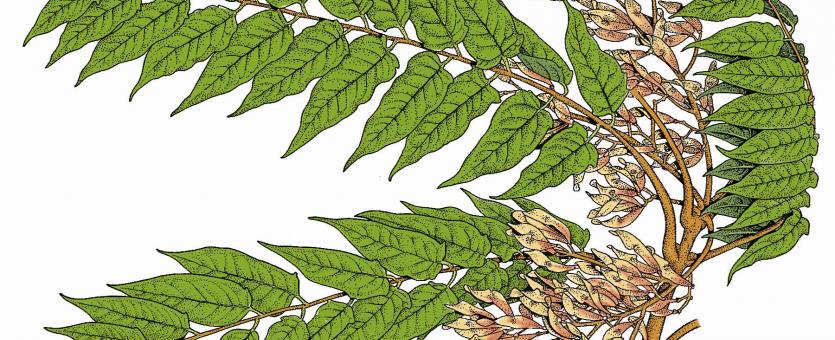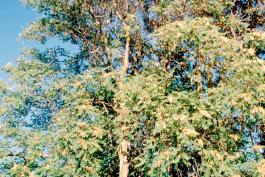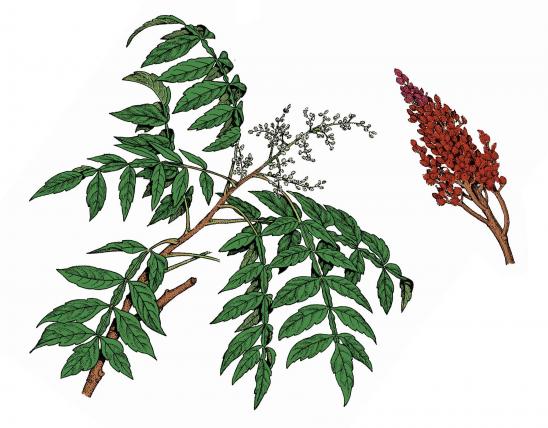
Tree-of-heaven is a medium-sized tree with stout branches spreading to form an open, very wide crown. It causes a skin rash in some people.
Leaves are alternate, feather-compound, to 2½ feet long, ill-scented when bruised; leaflets 11–41, 2–4 inches long, egg- or lance-shaped, pointed at the tip, margin smooth except for 2–4 glandular teeth at the base; leaf stalk swollen at the base; leaves turning yellowish-green in fall.
Bark is pale grayish-brown with shallow, light-colored grooves.
Twigs are stout, tan to reddish, with prominent, raised pores, ill-scented when broken, leaf scars large.
Flowers May–June, male and female flowers on separate trees, in clusters, 6–12 inches long, appearing after leaves have expanded; flowers small, about ⅓ inch wide, with 5 yellowish petals; male flowers ill-scented.
Fruits September–October, in clusters of 1–5 winged, one-seeded fruits, each fruit to 1½ inches long, wing twisted toward the end, light brown, persisting on tree into winter.
Height: to 60 feet.

Statewide.
Habitat and Conservation
Common in urban areas. Escapes from cultivation and spreads from old homesites. Can be found on the slopes of bluffs, in disturbed upland forests, and along stream edges. A native to China and Indonesia. Introduced to North America as a possible food plant for a proposed silkworm industry and also formerly much used in urban landscaping. This tree has invasive and weedy tendencies in many places where it is planted. It is hard to eradicate, and it should not be planted.
Status
A short-lived tree that grows rapidly, has brittle wood, resprouts after being cut, and reproduces readily from its abundant seeds. It is considered an invasive exotic in most of the places where it has been introduced. It can crowd out native plants and damage ecosystems. The genus name, Ailanthus, is pronounced "ay-LAN-thus" and is derived from a phrase in an Indonesian language (possibly the Kamarian phrase ai lanito) meaning "the sky tree."
Human Connections
In Asia this tree has many traditional and medicinal uses. As an urban tree it survives pollution and is tough and hardy, but it readily escapes and invades natural areas where it becomes weedy and crowds out native plants. Millions of dollars are spent each year controlling invasive plants.
Ecosystem Connections
This tree does little to feed larger forms of wildlife, but its presence over much of the United States enables the ailanthus webworm moth, whose larvae can only eat quassia-family plants, to expand its range far northward each summer from the southern states where it can survive winters.
Tree-of-heaven produces chemicals that suppress the growth of nearby plants, another factor that makes it a problematic invasive species.





























